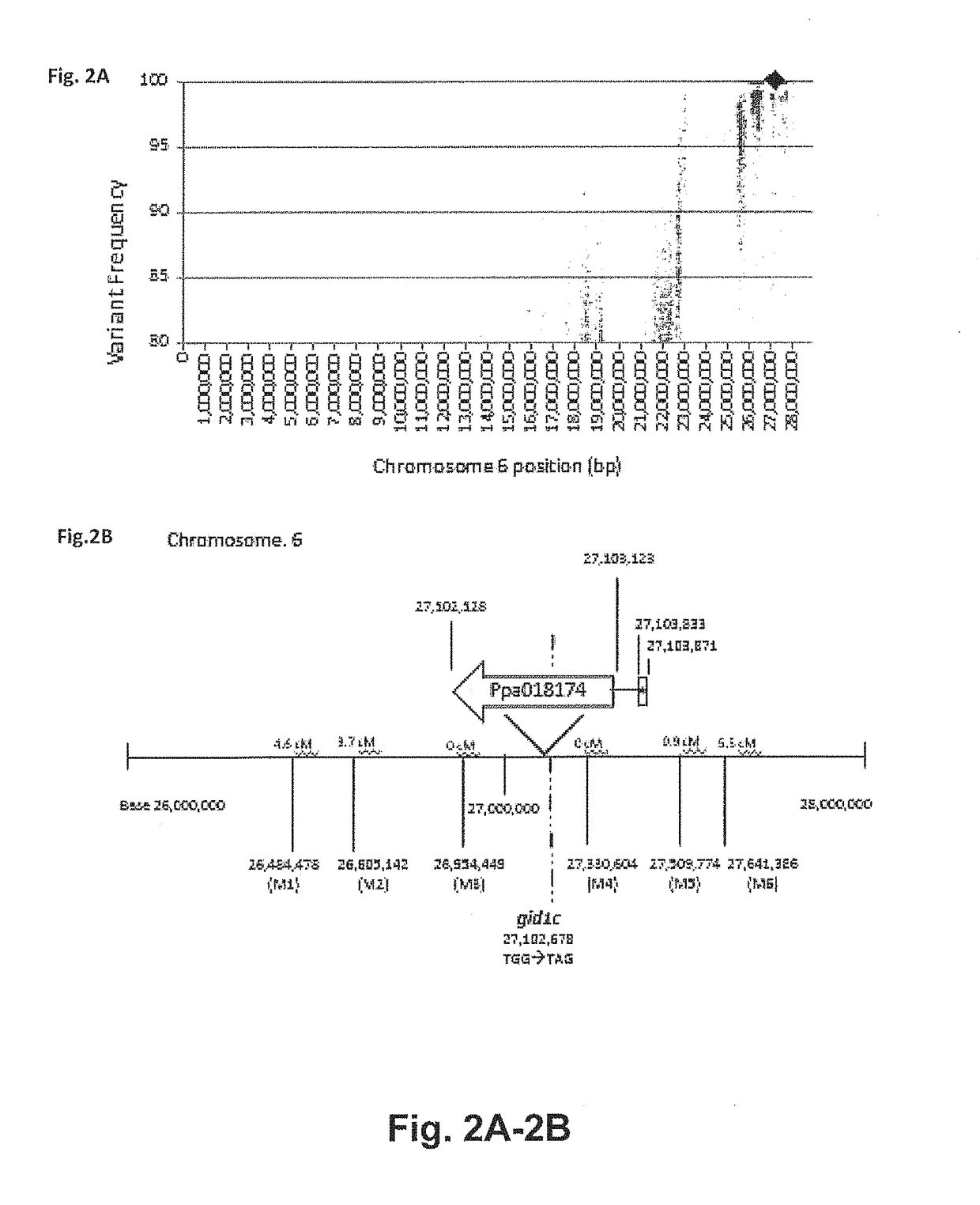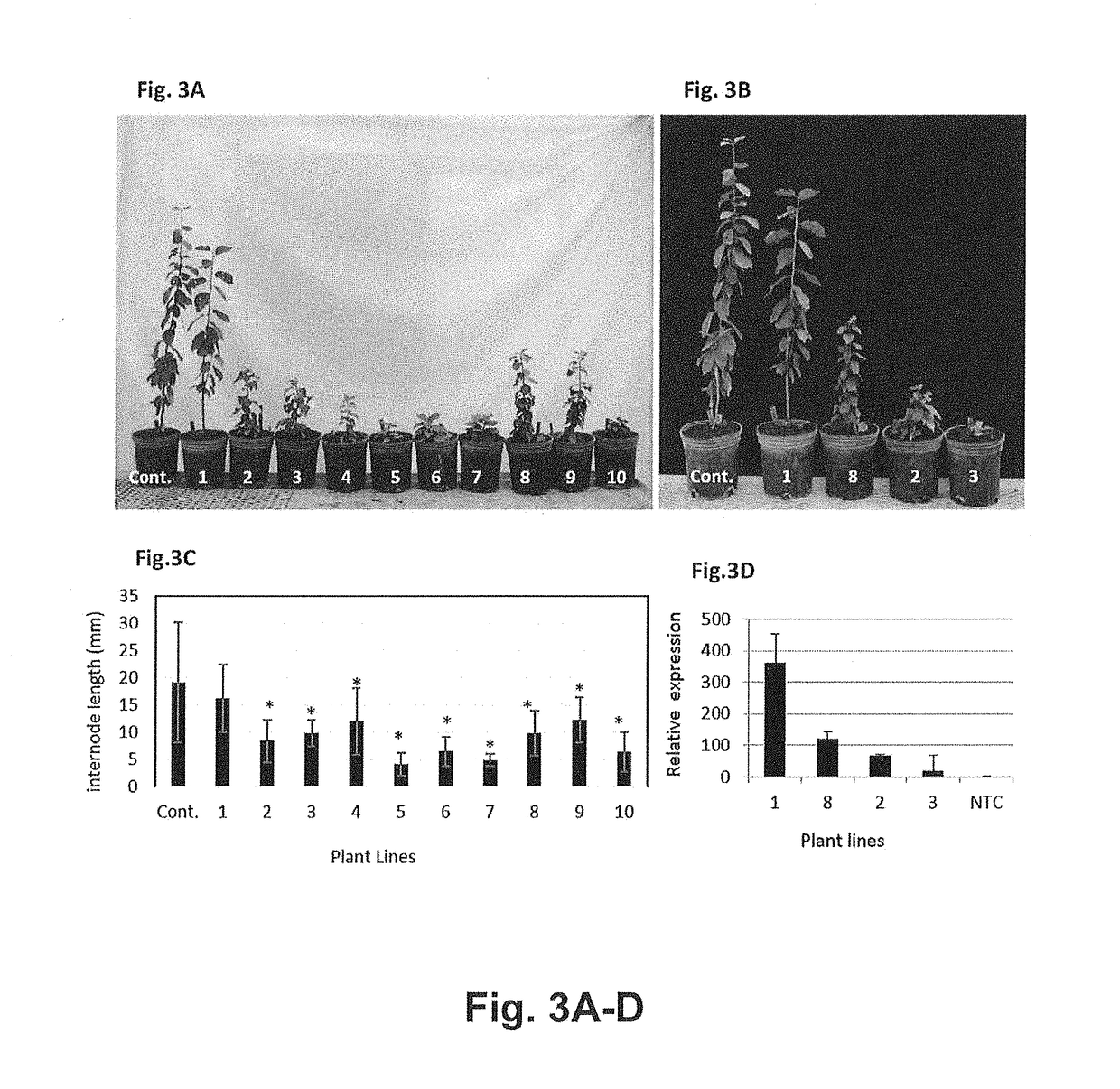Effect of PpeGID1c on vegetative growth of fruit trees
a fruit tree and ppegid1c technology, applied in the field of ppegid1c on the vegetative growth of fruit trees, can solve the problems of dwarfism in both trees and herbaceous species, cost and labor costs, and increased material and labor costs
- Summary
- Abstract
- Description
- Claims
- Application Information
AI Technical Summary
Benefits of technology
Problems solved by technology
Method used
Image
Examples
example 1
Peach Germplasm and Crosses
[0049]The dw trait used in this study originated from the dwarf cultivar ‘Valley Red’ and was obtained from the University of California, Davis. ‘Valley Red’ trees were hybridized to produce peach populations segregating for the dwarf phenotype. An individual F2 tree, previously shown to be heterozygous, was selfed to produce a single segregating population of approximately 140 individuals which were used in the current study.
example 2
DNA Extraction and Pnome Mapping
[0050]To map the peach dw trait from peach tree populations, a strategy for simultaneous genetic mapping and candidate gene identification using next-generation sequencing of pooled genomes, dubbed “pnomes” was utilized (Dardick et al. 2013. Plant J. 75:618-630). The pnomes strategy is based on sequencing a population(s) of segregating individuals pooled by a specific trait(s). In theory, the linkage of individual polymorphisms to a trait of interest should be measurable by calculating the abundance of each polymorphism within a given pnome assembled against a reference genome. Tightly linked polymorphisms should occur at high frequency in the pnome containing the trait while those same polymorphisms should be rare or absent in the pnome lacking the trait, and vice versa. Consequently, when graphed by nucleotide position, the data should produce a bell-shaped curve delineating the location of the trait. To test the efficacy of the pnomes strategy, DNA...
example 3
Plum Transformation
[0058]A 249 bp fragment (SEQ ID NO:4) of the peach GID1c gene (Ppa018174) (SEQ ID NO:1) was amplified from DNA derived from the standard size peach variety ‘True Gold’ using the following primers: GID1a-silence-F1 (5′ATGGATGGACAGCCCTGC; SEQ ID NO:20) and GID1a-silence-R1 (5′GGTCTTGGATGGTGACAAAGTATTT; SEQ ID NO:21). The resulting fragment was cloned into the Invitrogen pCR™8 / GW / TOPO® TA vector, and then transferred to into the pHELLSGATE 8.0 vector in a hairpin arrangement via Gateway cloning technology (Life Technologies, Frederick, Md.). This fragment (SEQ ID NO:4) was chosen due to a lack of similarity to GID1b (FIG. 6) in order to avoid silencing both genes.
[0059]The pHELLSGATE 8.0 plasmid containing peach GID1a gene were transformed into Agrobacterium tumefaciens strain GV3101. The gene construct was engineered into European plum (Prunus domestica L) following the protocol of Petri et al. (2012. Methods Mol. Biol. 847:191-199). Cold (4° C.)—stored seeds of ‘Bl...
PUM
| Property | Measurement | Unit |
|---|---|---|
| length | aaaaa | aaaaa |
| size | aaaaa | aaaaa |
| height | aaaaa | aaaaa |
Abstract
Description
Claims
Application Information
 Login to View More
Login to View More - R&D
- Intellectual Property
- Life Sciences
- Materials
- Tech Scout
- Unparalleled Data Quality
- Higher Quality Content
- 60% Fewer Hallucinations
Browse by: Latest US Patents, China's latest patents, Technical Efficacy Thesaurus, Application Domain, Technology Topic, Popular Technical Reports.
© 2025 PatSnap. All rights reserved.Legal|Privacy policy|Modern Slavery Act Transparency Statement|Sitemap|About US| Contact US: help@patsnap.com



